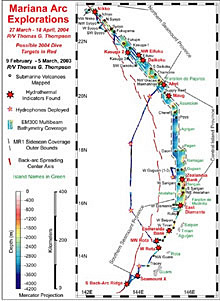
Mariana Island Arc volcanoes are overlain with the track of the T.G. Thompson's 2003 cruise. Symbols for various features are shown in the legend. The names of volcanoes indicated with red stars are possible ROPOS dive sites this year. Click image for larger view.
Exploring the Mariana Arc:
2004 Submarine Ring of Fire Expedition
Bob Embley
Geophysicist
Pacific Marine Environmental Laboratory, NOAA
The 2004 Submarine Ring of Fire expedition on the research vessel T.G. Thompson will depart from Guam* on March 27 and arrive in Yokohama, Japan on April 18. Using a sophisticated underwater tethered robot called ROPOS, the expedition will explore submarine volcanoes along more than 1,000 km of the Mariana Island Arc. The ROPOS will make a series of dives and collect samples and images of sea-floor hot springs.
The region lies within the farthest reaches of U.S. waters in the vicinity of the Territory of Guam and the Commonwealth of the Northern Mariana Islands. The 1,200-km-long chain of volcanoes lies only 200 km west of the Mariana Trench, where the westernmost, oldest portion of the Pacific tectonic plate begins its plunge back into the Earth’s mantle. These volcanoes, some of which have emerged as islands, rise more than 3,000 m (almost 10,000 ft) from the deep-sea floor.
This year's expedition is a followup to last year's, which discovered 10 new submarine hydrothermal systems along the Mariana Arc volcanic chain during February and March 2003. Thirty-four scientists are taking part in this year's expedition, including specialists in the fields of submarine volcanology, microbiology, hydrothermal vent ecology, physical oceanography, marine geology, chemistry, and economic geology. They represent four U.S. universities and two U.S. government agencies (the National Oceanic and Atmospheric Administration and the U.S. Geological Survey), three Canadian universities, a Japanese university and a Japanese government agency, and a research institute in New Zealand.
Characterizing the Arc's Hydrothermal Systems
A major goal is to characterize the biology and chemistry of the hydrothermal systems along the arc. The volcanoes along island arcs have a relatively high silica content in their magmas and tend to contain excess magmatic gas. These two properties combine to make island arc volcanoes more explosive (and usually more dangerous) than their counterparts along the mid-ocean ridge and the large “shield” volcanoes such as those that comprise Hawaii. In comparison to mid-ocean ridge volcanoes, the submarine volcanoes along island arcs have been relatively unexplored with the latest exploration tools. Preliminary work at a few sea-floor sites and analyses of last year's water samples from the active vents indicate that island arc hydrothermal systems are probably quite different in character from those found along the mid-ocean ridge. This expedition is one of the first comprehensive investigations of this submarine environment.
Surface and Underwater Research Platforms
The expedition will depend heavily on the research vessel T.G. Thompson and the undersea tethered robot ROPOS. The T.G. Thompson is one of seven U.S. academic/government research vessels of the Global Class capable of operating in remote parts of the world’s oceans for extended periods of time. In addition to serving as an excellent platform for ROPOS with its computer-controlled pinpoint positioning system, the T.G. Thompson can conduct surveys of the sea floor and the overlying ocean with its array of hull-mounted sonars and wire-borne instrumentation. The T.G. Thompson, operated by the University of Washington ![]() , and its complement of 20 professional seamen, engineers and technicians, have years of collective experience carrying out scientific expeditions in the Pacific, Indian and Antarctic oceans.
, and its complement of 20 professional seamen, engineers and technicians, have years of collective experience carrying out scientific expeditions in the Pacific, Indian and Antarctic oceans.

The ROPOS remotely operated vehicle is launched from the T.G. Thompson for its descent to the ocean floor. Click image for larger view.
The ROPOS is a tethered undersea robot that has served as a primary science platform for more than a decade. Many scientists on this expedition have prior experience with ROPOS and its operators from the Canadian Scientific Support Facility ![]() based in Sydney, British Columbia, Canada. ROPOS is equipped with two multifunction manipulator arms and a large array of specialized video, still cameras, sonar, and sampling gear. The scientists will use the vehicle to map and image the sea floor, and to collect samples of vent fluids, unusual life forms, mineral and volcanic rocks, and other interesting materials.
based in Sydney, British Columbia, Canada. ROPOS is equipped with two multifunction manipulator arms and a large array of specialized video, still cameras, sonar, and sampling gear. The scientists will use the vehicle to map and image the sea floor, and to collect samples of vent fluids, unusual life forms, mineral and volcanic rocks, and other interesting materials.
The wide range of scientific expertise on this cruise, together with state-of- the-art tools and the region's relatively undersampled hydrothermal and volcanic sites, increase the likelihood that we will make exciting new scientific discoveries. Join us as we explore the fascinating submarine volcanoes of the Mariana Arc.
*Guam was the first landfall in the Pacific Ocean for one of the greatest voyages of exploration in history. Ferdinand Magellan reached Guam on March 6, 1521, more than three months after emerging from the straits that bear his name.



























